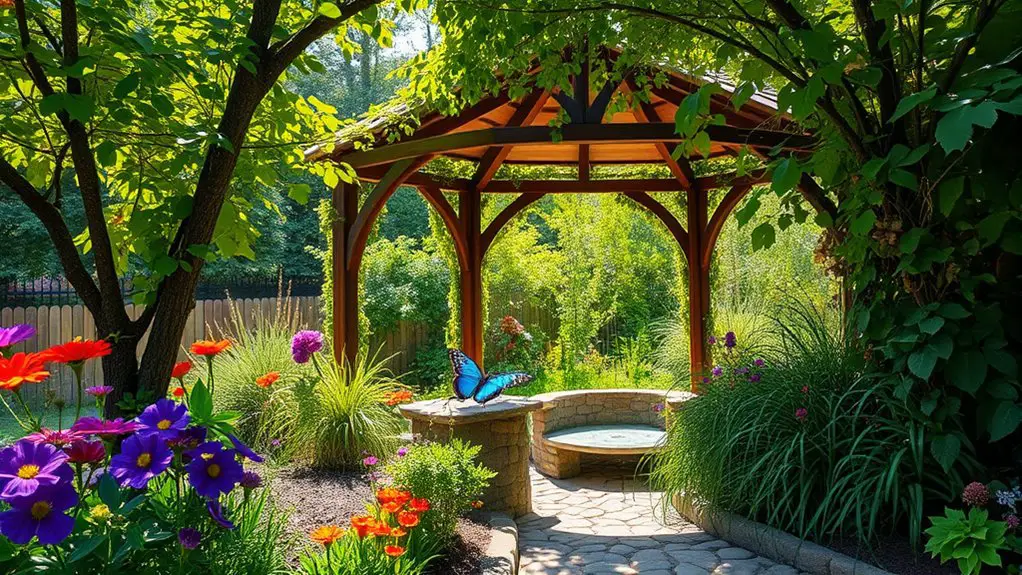To make your gazebo part of a wildlife-friendly garden, choose a sunny, well-drained spot for ideal comfort. Surround it with native plants that thrive in your local climate, attracting pollinators and birds. Add birdhouses and feeders to invite avian visitors, and include water features like birdbaths to support wildlife. Consider designing natural shelters with logs and brush piles for small animals. With thoughtful planning, your gazebo can become a vibrant oasis that invites in the wonders of nature. There’s so much more to explore!
Choosing the Right Location for Your Gazebo
When you’re picking the perfect spot for your gazebo, it’s essential to contemplate both aesthetics and functionality. Imagine a location where you can soak in the beauty of nature while enjoying the comfort of shade. Consider sunlight exposure: you’ll want your gazebo to bask in gentle morning rays, avoiding the harsh afternoon sun. This way, you create a serene retreat that invites relaxation.
Equally important is ground drainage. Placing your gazebo on a well-drained area prevents water accumulation, keeping the space cozy and dry. Look for high ground, away from potential flooding zones. Additionally, ensure that the gazebo is located in a space that is accessible and maintains easy reach from the home, enhancing your overall experience.
Incorporating Native Plants Around the Gazebo
Surrounding your gazebo with native plants not only enhances its beauty but also creates a harmonious ecosystem that benefits local wildlife. Native plants thrive in your region’s climate, requiring less water and maintenance, which means you can spend more time enjoying your space. By incorporating a variety of species, you’ll promote plant diversity, attracting a wider range of pollinators and beneficial insects.
Imagine vibrant wildflowers, lush ferns, and sturdy shrubs weaving together around your gazebo, creating a natural tapestry that invites life. As butterflies flit and bees buzz, you’ll witness the magic of nature right at your doorstep.
Furthermore, native plants provide essential food and shelter for birds and small mammals, enriching the biodiversity of your garden. So, embrace the freedom of nature’s palette and transform your gazebo into a sanctuary for wildlife, where beauty and ecological balance coexist beautifully.
Adding Birdhouses and Feeders to Attract Avian Visitors
To create a vibrant haven for birds, consider adding birdhouses and feeders near your gazebo, where they can easily be spotted from your cozy seat. Choose various birdhouse styles—think whimsical shapes or rustic designs—that blend harmoniously with your garden’s aesthetic. Position them at different heights to attract a diverse range of feathered friends.
Feeder placements are equally vital; hang them in visible spots, but away from windows to prevent collisions. Opt for tube feeders for small birds and platform feeders for larger ones.
Remember to fill your feeders with high-quality seeds, such as sunflower or nyjer, to entice a colorful array of visitors. Regularly clean and refill them to keep your avian guests happy and healthy. By creating this inviting atmosphere, you’ll turn your gazebo into a delightful birdwatching spot, where nature’s symphony unfolds right before your eyes.
Creating Butterfly Habitats With Nectar Plants
As you cultivate your garden oasis, incorporating nectar-rich plants can transform it into a vibrant butterfly haven. By choosing the right nectar sources, you can attract a diverse array of butterfly species, each adding beauty and life to your space. Opt for perennials like coneflowers and butterfly bush, which are known for their abundant blooms and sweet nectar.
Create clusters of these plants to make them easily accessible for butterflies. Their vivid colors will not only delight your senses but also entice fluttering visitors. Consider planting a variety of heights and textures to mimic natural habitats, allowing butterflies to feel at home.
Don’t forget to include plants that bloom at different times throughout the season, ensuring a continuous supply of nectar. With just a little effort, you’ll have a sanctuary that celebrates the freedom and grace of these enchanting creatures, filling your garden with their delicate dance.
Utilizing Water Features to Support Wildlife
Imagine the gentle sound of water trickling through your garden, inviting a symphony of wildlife to visit. From serene ponds to bubbling fountains, different water features can create habitats that sustain birds, frogs, and beneficial insects. With a little care and maintenance, these sparkling additions become essential lifelines for your garden’s ecosystem.
Types of Water Features
While creating a wildlife-friendly garden gazebo, incorporating various water features can greatly enhance the habitat for local fauna. Consider adding pond types like naturalistic ponds, which provide a serene environment for frogs and dragonflies, or smaller, wildlife-friendly birdbaths that offer hydration and bathing opportunities. Fountain styles, such as bubbling rock fountains or tiered water features, not only create soothing sounds but also attract birds and beneficial insects. These elements invite life while promoting biodiversity. Remember, the movement of water is essential; it encourages wildlife to visit. With the right combination of water features, your gazebo can become a vibrant sanctuary, harmonizing nature and tranquility in your outdoor space. Let your garden be a haven for all creatures!
Maintenance for Wildlife Health
To guarantee your wildlife-friendly garden gazebo thrives, regular maintenance of water features is essential for supporting local fauna. Keep your ponds and fountains clean, ensuring they’re free from debris that can disrupt habitat restoration efforts. Regularly check water levels and quality; this helps with wildlife monitoring, providing a healthy environment for frogs, birds, and beneficial insects. Consider adding native aquatic plants to enhance the ecosystem and offer shelter. If you notice any signs of imbalance, act swiftly to revive the habitat. By nurturing these features, you’re not just creating a serene retreat but also encouraging a vibrant community of wildlife, all thriving in the freedom of your garden’s embrace. Your efforts will yield a sanctuary for nature’s beauty to flourish.
Installing Pollinator-Friendly Features
As you begin creating a wildlife-friendly garden gazebo, incorporating pollinator-friendly features can transform your space into a vibrant ecosystem buzzing with life. Start by planting a variety of native flowers in your surrounding garden, forming beautiful pollinator gardens that attract bees, butterflies, and hummingbirds. These colorful blooms not only enhance your gazebo’s aesthetic but also provide essential nectar and pollen.
Consider adding bee hotels, specially designed homes that offer shelter for solitary bees. Position these charming structures near your gazebo to encourage pollinator visits. You might also include shallow water sources, like birdbaths with stones for perching, to help thirsty pollinators.
Designing Natural Shelters for Small Animals
Creating a wildlife-friendly garden gazebo isn’t just about aesthetics; it’s also about providing safe havens for small animals. By incorporating thoughtful shelter design using natural materials, you can invite a variety of creatures into your outdoor sanctuary. Here are three ways to create these cozy retreats:
- Brush Piles: Stack branches and leaves in a corner to form a natural shelter, perfect for small mammals and insects seeking protection.
- Rock Crevices: Arrange stones to create nooks where lizards and other critters can hide from predators, enjoying the warmth of the sun.
- Hollow Logs: Place logs horizontally in your garden. These not only provide homes for insects but also serve as a resting spot for small birds.
Embrace the beauty of nature while ensuring your gazebo becomes a nurturing environment for these delicate beings. Your garden can flourish, supporting life in all its forms.
Implementing Sustainable Practices in Your Garden
Creating a vibrant garden starts with choosing native plants that thrive in your local ecosystem, inviting both beauty and biodiversity. By incorporating organic pest control methods, you’ll protect your plants while fostering a healthy habitat for wildlife. Let’s explore how these sustainable practices can transform your garden into a flourishing retreat.
Native Plant Selection
While many gardeners dream of lush landscapes filled with vibrant blooms, selecting native plants not only enhances your outdoor aesthetic but also supports local wildlife and ecosystems. By embracing plant diversity, you create a rich habitat that fosters pollinator partnerships. Here are three native plants to evaluate:
- Echinacea (Coneflower) – Attracts bees and butterflies with its striking petals and nectar-rich blooms.
- Asclepias (Milkweed) – Essential for monarch butterflies, providing a critical food source for larvae.
- Rudbeckia (Black-eyed Susan) – Hardy and beautiful, these flowers offer seeds for birds and nectar for pollinators.
Organic Pest Control
How can you maintain a thriving garden without relying on harsh chemicals? Embrace organic pest control! Start by attracting beneficial insects like ladybugs and lacewings, which feast on pesky pests. Planting flowers like marigolds or dill can naturally draw these helpers to your space. You can also use natural repellents, like neem oil or garlic spray, to deter unwanted guests without harming the ecosystem. Consider introducing companion planting—pairing plants that support each other’s growth while keeping pests at bay. With these sustainable practices, your garden can flourish freely, creating a sanctuary not just for you, but for the wildlife that calls it home. Your gazebo becomes a peaceful retreat amidst a vibrant, thriving habitat, effortlessly intertwined with nature.
Enhancing Your Gazebo With Wildlife Observation Areas
To truly appreciate the beauty of nature, you can enhance your gazebo by incorporating dedicated wildlife observation areas. These spaces not only invite a closer connection with local fauna but also transform your gazebo into a serene retreat. Here are some gazebo enhancements to reflect on:
Enhance your gazebo with wildlife observation areas for a serene retreat and a deeper connection to nature.
- Native Plant Gardens: Surround your gazebo with native plants that attract butterflies, birds, and beneficial insects. This creates a vibrant ecosystem right at your doorstep.
- Bird Feeders and Baths: Add bird feeders and baths near your gazebo. This will draw in various bird species, offering you delightful wildlife observation opportunities.
- Insect Hotels: Construct insect hotels nearby to support pollinators like bees and butterflies. Watching these tiny creatures thrive adds a unique charm to your outdoor experience. Additionally, incorporating elements like shade structures can enhance both comfort and wildlife visibility while enjoying your gazebo.
Frequently Asked Questions
How Do I Choose Wildlife-Friendly Furniture for My Gazebo?
When choosing wildlife-friendly furniture for your gazebo, look for eco-friendly seating crafted from natural materials. This not only enhances your outdoor space’s aesthetics but also creates a harmonious environment for nature’s creatures to thrive.
Can I Use Pesticides in My Wildlife-Friendly Garden?
Using pesticides in your garden isn’t ideal if you want to attract beneficial insects. Instead, explore pesticide alternatives like neem oil or companion planting, letting nature thrive while keeping your space safe and vibrant.
What Materials Are Best for a Wildlife-Friendly Gazebo?
For your wildlife-friendly gazebo, consider using recycled materials like reclaimed wood or metal. Opt for natural finishes, ensuring the structure blends harmoniously with nature, inviting both you and wildlife to enjoy its serene beauty.
How Do I Maintain a Wildlife-Friendly Gazebo Year-Round?
Your gazebo could become a wildlife utopia with just a bit of seasonal upkeep! Regularly check for damage, add habitat enhancements like native plants, and guarantee water sources are clean for happy critters year-round.
Are There Specific Plants to Avoid Near My Gazebo?
When choosing plants near your gazebo, steer clear of invasive species and those with plant toxicity. They can harm wildlife and disrupt your garden’s balance, limiting the freedom of nature’s vibrant tapestry surrounding your peaceful retreat.

